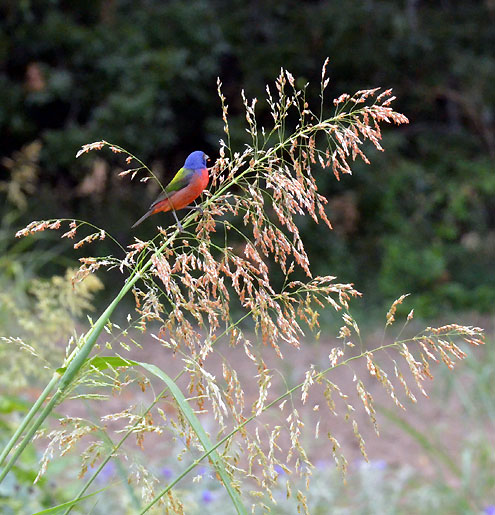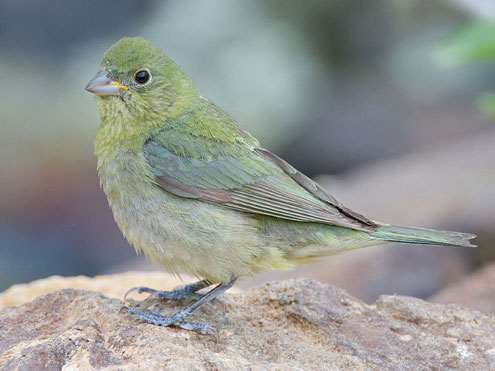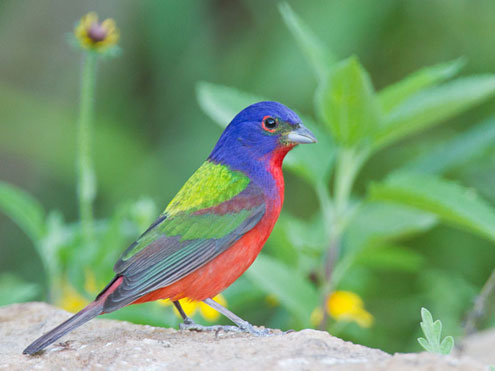Are painted buntings are becoming more common?
Dr. Wayne Meyer: According to Breeding Bird Survey data, the species is in decline at about 1% per year. However, that slide has slowed over the last 6 or 7 years. No one knows why, nor do we really know why the population is in decline in the first place. Painted buntings depend on early successional fields, and they are most common in areas that have open grassland with small honey locust, mesquite, or other trees that like to invade abandoned pastures. The bird feed on grass seeds and insects, but build their nests in small trees about 3-5 feet off the ground. Honey locust and mesquites have thorns to deter predators from getting at the nests. I suspect that the recent stabilization of bunting numbers is somehow related to decreased numbers of people raising cattle. As fields are disused, the trees start moving in and the buntings follow. Of course, clearing those fields to build homes will inevitably drive the buntings away.
Last spring I heard lots of people telling me they had painted buntings at their backyard feeders. If you recall, last winter and spring was unusually cold, so grasses were slow getting started. As the buntings arrived in April and May they probably weren't finding as much food as they were used to, so they went to feeders. They seem to really like white millet seeds and will readily feed from hopper feeders with perches, unlike most sparrows that prefer to feed on the ground. If water is also provided, you'll increase the chances of getting a visit or two. Unfortunately, it is pretty rare that they continue to use a feeder for more than a few days. Only a few lucky people get painted buntings to come all summer.

A male painted bunting surveys his surroundings from a stalk of Johnson grass. photo by Allen Rich
One of the more interesting things about this species is that adult males migrate three times each year. In addition to moving south for the winter and north in the summer, buntings in western and central Texas fly to western New Mexico and Arizona in July. Breeding usually ends about that time, so males leave the females to raise any young birds. Late July and early August are when the monsoons arrive in Arizona and New Mexico, so the birds take advantage of the rains to molt where there is an abundant food supply. Presumably females who haven't any young also go, but most females that are rearing young will stay here in Texoma through September.

Close-up of a female or young male painted bunting -
photo by Dan Pancamo
As they prepare to fly south in September they may come to feeders again. Remember that young birds of both sexes retain the female-like yellow-green plumage. A few bright males will stay as well; I have a photo of one that was photographed on a back deck in the middle of a snow storm in December.
What intrigues you most about painted buntings?
Dr. Meyer: One-year-old males retain the female-like plumage even though they are physically able to hold a territory and can occasionally attract a female. It is very unusual for birds that size to give up a first summer's chance at breeding. We don't have data for painted bunting lifespans, but most small sparrow-like birds are lucky to live one year, meaning that not having all the bright feathers means you may be giving up on breeding that first year. I have been doing research on the buntings at Hagerman National Wildlife Refuge and several field sites owned by Austin College since 2002 trying to figure out why these birds don't get their fancy feathers for an extra year. So far it looks like there are too many older males for the available habitat, so youngsters gain by keeping the better camouflage of the green plumage until they are two years old and better able to hold and keep a territory.
Probably the second thing that intrigues me most about them is that so many people think they are secretive. Several years ago Birder's World magazine asked their readers what species they most wanted to see and painted bunting was second behind only ivory-billed woodpecker. At Hagerman National Wildlife Refuge, I routinely record songs from fifty or more males. They are actually really easy to find once you are in the right habitat and know what sound to chase after. They don't like human disturbance, so they don't come into towns often, and I think that is why so many people think they are secretive. The best thing one can do to increase the chances of seeing one is to learn what the song sounds like. Males sing from very exposed perches in attempts to attract females, so when you hear a bird you just have to check the tops of the trees nearby and he should be in there.
What can North Texans do to encourage the buntings?
Dr. Meyer: Unfortunately, not much. Put white millet in your bird feeders in April, May or September. Make water available, especially if we have another summer drought. The best thing is to get outdoors in grassy fields with small trees and look for singing males in May, June and early July. The pretty males all leave North Texas by the 20th of August (of course there's always one bird that can't read the notice). The plain-Jane females and young will stay around through September. Since they prefer weeds and knee-high grass, they aren't very likely to spend any time in suburban yards, but ranches can be very attractive.

Male painted bunting - photo by Dan Pancamo
To listen to this colorful songbird, visit http://www.allaboutbirds.org/guide/Painted_Bunting/id/ac